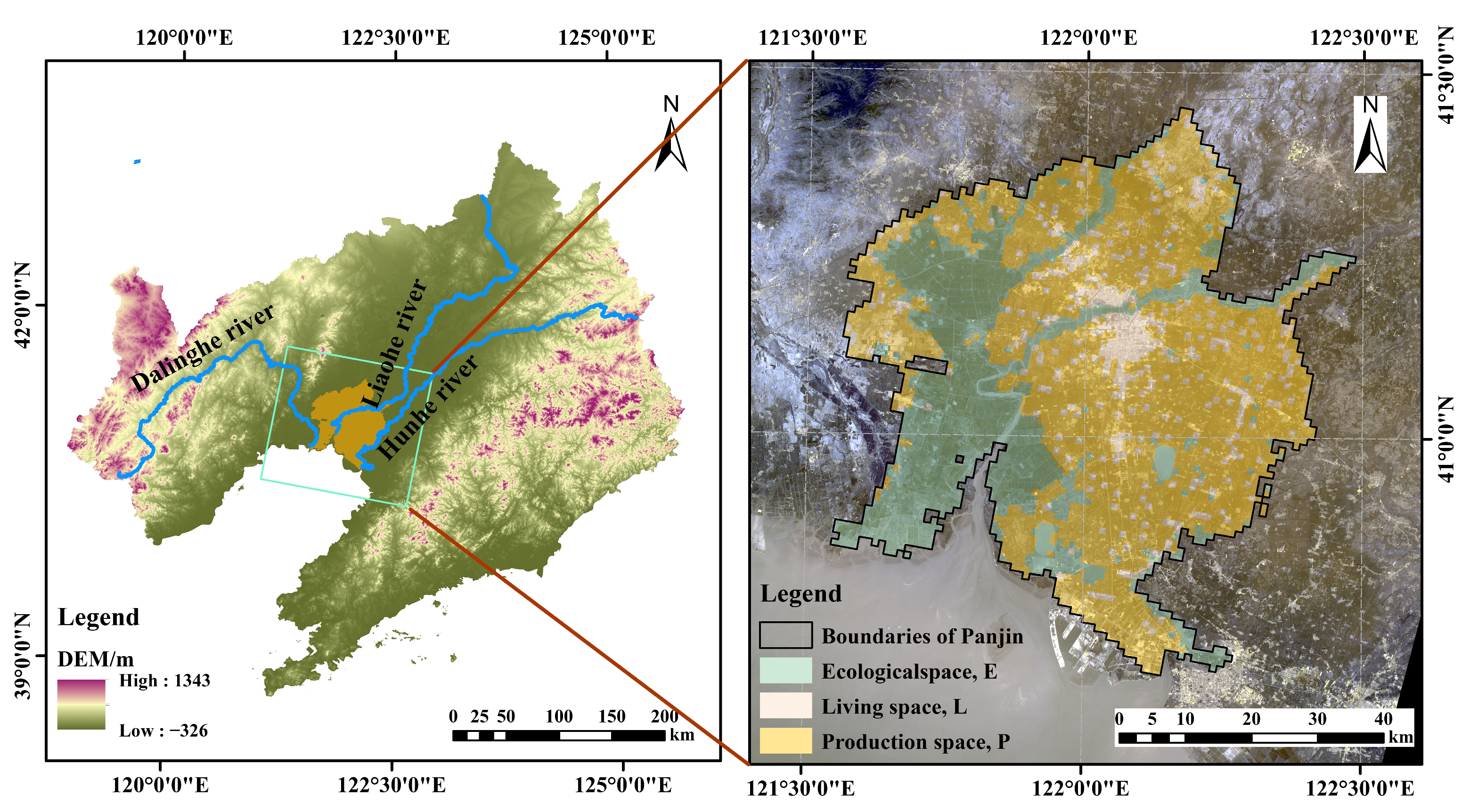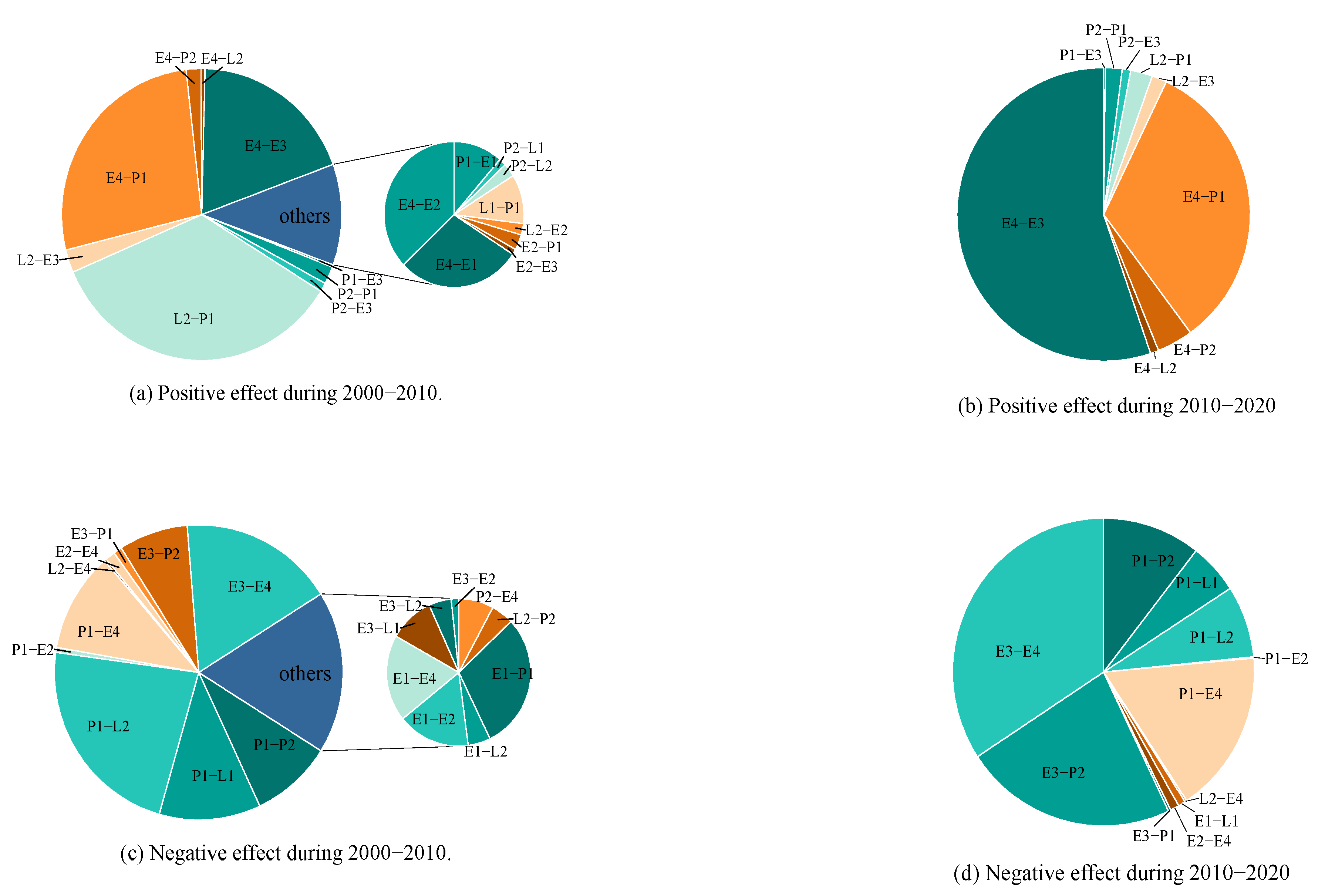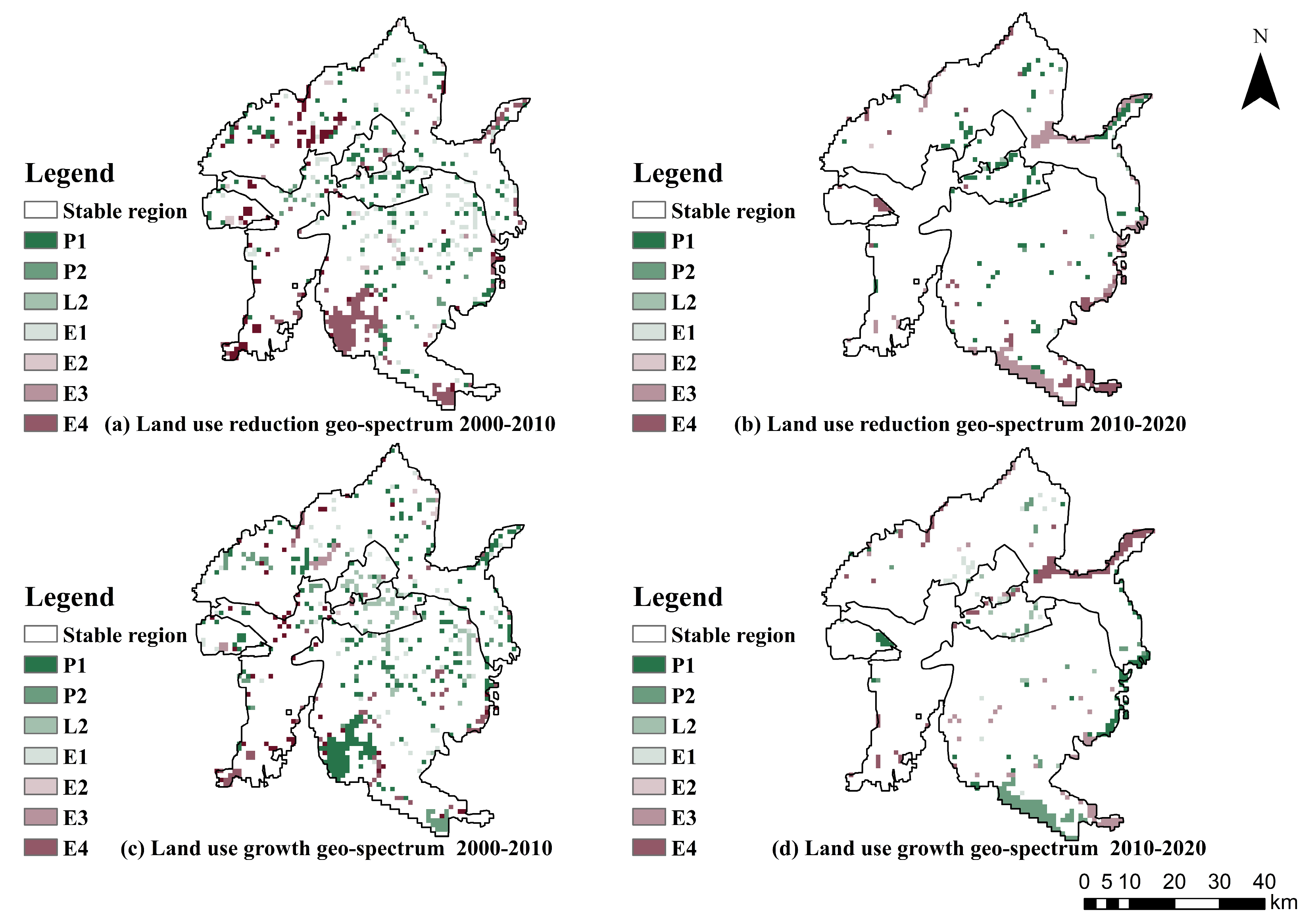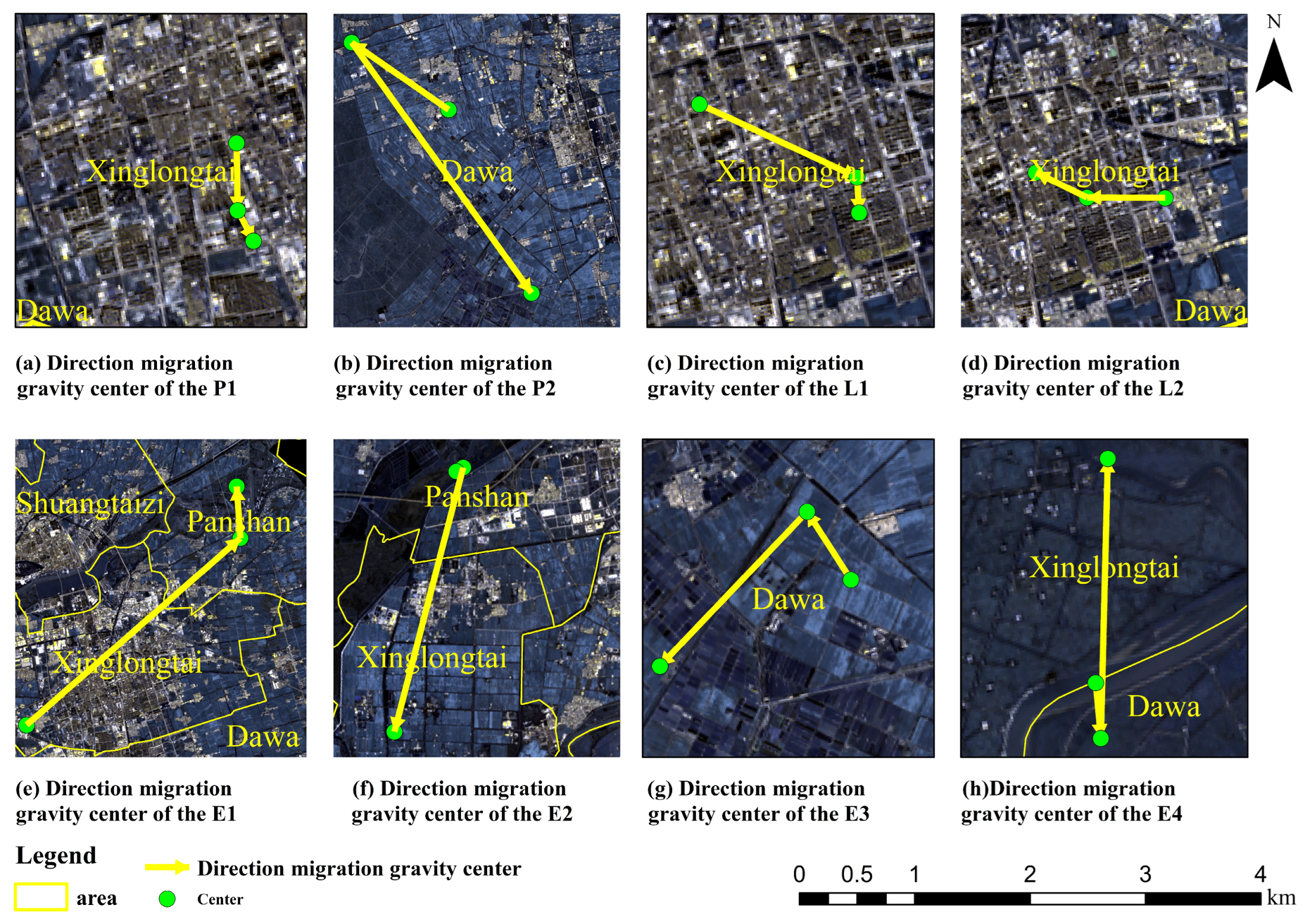Study on the Evolution of the Urban Land Use and the Driving Mechanism from the Perspective of the “Productive–Living–Ecological” Spaces
Abstract
:1. Introduction
2. Methods and Materials
2.1. Study Area
2.2. Data Processing
2.3. Methodology
2.3.1. Classification of “PLES” and Land Space Function Assignment
2.3.2. Transfer Matrix
2.3.3. Dynamic Attitude
2.3.4. Ecological Environment Quality Index Model
2.3.5. Ecological Contribution Rate
2.3.6. Center of Gravity Migration Model
2.3.7. Geographical Detector Model
3. Results and Discussion
3.1. Examination of the Ecological Impact of the Evolution of the “PLES”
3.1.1. Ecological Environment Quality Index
3.1.2. Analysis of Ecological Contribution Rate
3.2. Analysis of the Spatial and Temporal Evolution of the “PLES”
3.2.1. Evolution of the Spatial Pattern of the “PLES”
Transfer Matrix Analysis
Changing Attitudes to “PLES” Dynamics
3.2.2. Evolution of the “PLES” Structure
“PLES” Growth and Reduction Based on the Geo-Spectrum
3.2.3. Characteristics of the Evolution of the Center of Gravity of the “PLES”
3.3. Analysis of the Drivers of “PLES”
3.3.1. Parameter Optimal Classification Method Selection
3.3.2. Factor Detection Analysis
3.3.3. Analysis of Factor Interaction Detection
3.4. Discussion
4. Conclusions
- (1)
- In terms of the evolution of the “PLES” pattern, by 2020 the production and living spaces will continue to increase to 2093 km2 and 380 km2 respectively, while the ecological space will show a general downward trend and decrease to 1145 km2. Further analysis according to the change in the area shows that the center of gravity of P2, L1, E3, and E2 is shifting southwards, while the center of gravity of E1 is shifting northwards, mainly due to the establishment of protected areas by relevant enterprises to protect a certain resource, the demand for education, the desire for a good job and the response to the local demand for environmental protection.
- (2)
- From the development of the pattern of “PLES”, it can be seen that the ecological space area is decreasing, and then the ecological effect of “PLES” is studied by using the ecological environment quality index as well as the ecological contribution rate method, and from 2000 through 2020, the index shows a general declining pattern, and the value of the ecological contribution rate of the negative effect is larger than the value of the positive effect, so the ecological condition of Panjin is getting worse, so Panjin should strengthen the scientific planning and ecological environment management of “PLES” to enhance the ecological surroundings quality of Panjin.
- (3)
- Natural and social factors work together to form and develop the “PLES”, and the results of geographic exploration indicate that, of the natural factors, the annual average temperature has the biggest impact on the development of the “PLES”. The use of geographic probes to analyze the interaction of the two factors also reveals that the ultimate outcome of each factor’s interaction with the other is an increase in the influence of the two factors, The final result gives the strongest explanatory power in the two-factor interaction, as mean annual temperature interacts with the density of population. Overall, the mean annual temperature and density of the population are the key factors affecting the ecological environment in Panjin, therefore, ecological protection zones should be created and population patterns should be optimized in order to reduce the impact of humanity activity on the environment.
Author Contributions
Funding
Informed Consent Statement
Data Availability Statement
Conflicts of Interest
Appendix A
| Period | Type of Transformation | Conversion Area/km2 | Ecological Contribution Rate (10−4) | Percentage of Contribution Rate (%) |
|---|---|---|---|---|
| 2000–2010 | P1−E1 | 3 | 2.7 | 1.27% |
| P1−E3 | 34 | 0.6 | 0.28% | |
| P2−P1 | 4 | 4.1 | 1.94% | |
| P2−L1 | 3 | 0.4 | 0.19% | |
| P2−L2 | 5 | 0.7 | 0.33% | |
| P2−E3 | 2 | 2.1 | 0.99% | |
| L1−P1 | 3 | 2.6 | 1.23% | |
| L2−P1 | 84 | 73.6 | 34.73% | |
| L2−E2 | 1 | 0.6 | 0.28% | |
| L2−E3 | 6 | 5.4 | 2.55% | |
| E2−P1 | 3 | 0.8 | 0.38% | |
| E2−E3 | 1 | 0.3 | 0.14% | |
| E4−P1 | 42 | 57.5 | 27.14% | |
| E4−P2 | 10 | 3.6 | 1.70% | |
| E4−L2 | 2 | 1 | 0.47% | |
| E4−E1 | 3 | 6.8 | 3.21% | |
| E4−E2 | 8 | 8.8 | 4.15% | |
| E4−E3 | 29 | 40.3 | 19.02% | |
| sum | 211.9 | 100.00% |
| Period | Type of Transformation | Conversion Area/km2 | Ecological Contribution Rate (10−4) | Percentage of Contribution Rate (%) |
|---|---|---|---|---|
| 2010–2020 | P1−E3 | 10 | 0.2 | 0.19% |
| P2−P1 | 2 | 2 | 1.85% | |
| P2−E3 | 1 | 1 | 0.92% | |
| L2−P1 | 3 | 2.6 | 2.40% | |
| L2−E3 | 2 | 1.8 | 1.66% | |
| E4−P1 | 26 | 35.6 | 32.90% | |
| E4−P2 | 12 | 4.3 | 3.97% | |
| E4−L2 | 2 | 1 | 0.92% | |
| E4−E3 | 43 | 59.7 | 55.18% | |
| sum | 108.2 | 100.00% |
| Period | Type of Transformation | Conversion Area/km2 | Ecological Contribution Rate (10−4) | Percentage of Contribution Rate (%) |
|---|---|---|---|---|
| 2000–2010 | P1−P2 | 18 | 18.2 | 9.10% |
| P1−L1 | 26 | 22.8 | 11.40% | |
| P1−L2 | 52 | 45.5 | 22.75% | |
| P1−E2 | 4 | 1.1 | 0.55% | |
| P1−E4 | 16 | 21.9 | 10.95% | |
| P2−E4 | 8 | 2.8 | 1.40% | |
| L2−P2 | 13 | 1.8 | 0.90% | |
| L2−E4 | 1 | 0.5 | 0.25% | |
| E1−P1 | 12 | 10.7 | 5.35% | |
| E1−L2 | 1 | 1.8 | 0.90% | |
| E1−E2 | 5 | 5.8 | 2.90% | |
| E1−E4 | 3 | 6.8 | 3.40% | |
| E2−E4 | 2 | 2.2 | 1.10% | |
| E3−P1 | 102 | 1.9 | 0.95% | |
| E3−P2 | 15 | 15.5 | 7.75% | |
| E3−L1 | 4 | 3.6 | 1.80% | |
| E3−L2 | 2 | 1.8 | 0.90% | |
| E3−E2 | 2 | 0.6 | 0.30% | |
| E3−E4 | 25 | 34.7 | 17.35% | |
| sum | 200 | 100.00% |
| Period | Type of Transformation | Conversion Area/km2 | Ecological Contribution Rate (10−4) | Percentage of Contribution Rate (%) |
|---|---|---|---|---|
| 2010−2020 | P1−P2 | 24 | 24.3 | 10.52% |
| P1−L1 | 14 | 12.3 | 5.32% | |
| P1−L2 | 20 | 17.5 | 7.57% | |
| P1−E2 | 1 | 0.3 | 0.13% | |
| P1−E4 | 29 | 39.7 | 17.18% | |
| L2−E4 | 1 | 0.5 | 0.22% | |
| E1−L1 | 1 | 1.8 | 0.78% | |
| E2−E4 | 2 | 2.2 | 0.95% | |
| E3−P1 | 31 | 0.6 | 0.26% | |
| E3−P2 | 51 | 52.7 | 22.80% | |
| E3−E4 | 57 | 79.2 | 34.27% | |
| Sum | 231.1 | 100.00% |
References
- Fu, J.C.; Zhang, S.L. Functional assessment and coordination characteristics of production, living, Ecological Function—A Case Study of Henan Province, China. Int. J. Environ. Res. Public Health 2021, 18, 8051. [Google Scholar] [CrossRef] [PubMed]
- Tian, C.; Cheng, L.L.; Shao, Y.C. Characteristics of carbon metabolism efficiency and evolutionary patterns of urban tri-spatial carbon metabolism in the Beijing-Tianjin-Hebei region. Environ. Sci. 2024, 45, 1254–1264. [Google Scholar]
- Zhang, Y.L.; Luan, Q.L.; Xiong, C.S.; Liu, X. Evaluation of spatial heterogeneity and zoning of “production-living-ecological space” based on multi-source spatial data. J. Agric. Eng. 2021, 37, 214–223. [Google Scholar]
- Zhang, K.; Huang, C.H.; Wang, Z.Y.; Wu, J.Y.; Zeng, Z.Q.; Mu, J.J.; Yang, W.Y. Optimisation of the spatial pattern of Sansheng based on the DTTD-MCR-PLUS model—A case study of Changsha City. J. Ecol. 2022, 42, 9957–9970. [Google Scholar]
- Collins, G. The Ciudad Lineal of Madrid. J. Soc. Archit. Hist. 1959, 18, 38–53. [Google Scholar] [CrossRef]
- Collins, G. Linear Planning throughout the World. J. Soc. Archit. Hist. 1959, 18, 74–93. [Google Scholar] [CrossRef]
- Lampygnani, V. Architecture and City Planning of the Twentieth Century; Van Nostrand Reinhold: New York, NY, USA, 1980; p. 256. [Google Scholar]
- Choay, F. The Modern City Planning in the 19th Century; Collin, G., Translator; George Braziller: New York, NY, USA, 1969; p. 128. [Google Scholar]
- Paszkowska-Kaczmarek, N. The Line—The Saudi-Arabian Linear City Concept as the Prototype of Future Cities. Archit. Artibus 2021, 13, 33–46. [Google Scholar]
- Batty, M. The Linear City: Illustrating the logic of spatial equilibrium. Comput. Urban Sci. 2022, 2, 8. [Google Scholar] [CrossRef]
- Ward, S. The Garden City: Past, Present and Future, 1st ed.; Routledge: London, UK, 1992; p. 240. [Google Scholar]
- Totaforti, S. The Garden City and the American Dream. J. Mediterr. Knowl. JMK 2020, 5, 125–140. [Google Scholar]
- Jun, M.J. The Effects of Portland’s Urban Growth Boundary on Housing Prices. J. Am. Plan. Assoc. 2006, 72, 239–243. [Google Scholar] [CrossRef]
- Xiong, H.X.; Min, J. Spatial dynamic evolution of typical mountainous triple life and its influencing factors—Taking Xiushan County of Chongqing as an example. Agric. Technol. 2024, 44, 75–82. [Google Scholar]
- Wei, C.; Wu, Z.; Ye, S.; Wei, X.Y.; Yang, S.F. Analysis on the evolution of land space pattern and driving force of city cluster in the middle reaches of the Yangtze River under the perspective of three zones. Yangtze River Basin Resour. Environ. 2024, 33, 1489–1503. [Google Scholar]
- Yang, S.H.; Li, L.; Ma, J.D.; Guo, W.X. Land use transition and gradient effect in Shanxi Province from 1990 to 2020 under the perspective of production-living-ecological space. Arid Zone Res. 2024, 41, 1249–1258. [Google Scholar]
- Ding, H.M.; Yang, C.X.; Li, X.; Lv, Z.Q.; Zuo, Y.Y. Evolution of land use functions and their ecological and environmental effects in traditional agricultural areas of the plateau. Soil Water Conserv. Res. 2022, 29, 399–407. [Google Scholar]
- Chen, J.; Gao, M.; Cheng, S.L.; Hou, W.X.; Song, M.L.; Liu, X.; Liu, Y. Global 1 km × 1 km gridded revised real gross domestic product and electricity consumption during 1992–2019 based on calibrated nighttime light data. Sci Data 2022, 9, 202. [Google Scholar] [CrossRef] [PubMed]
- Xu, L.X. China GDP spatial distribution kilometer grid dataset. Resource and Environmental Science Data Registration and Publication System. Chin. Acad. Sci. 2017, 10, 2017121102. [Google Scholar]
- Li, X.W.; Fang, C.L.; Huang, J.C.; Mao, H.Y. Urban land use change in Northwest China and its regional ecological and environmental effects—A case study of Hexi area in Gansu. Quat. Res. 2003, 3, 280–290. [Google Scholar]
- Yang, Q.K.; Duan, X.J.; Wang, L.; Jin, Z.F. Land use transformation and ecological and environmental effects based on “production-living-ecological space”—A case study of the core area of the Yangtze River Delta. Geoscience 2018, 38, 97–106. [Google Scholar]
- He, Q.Z.; Xie, D.T.; Wang, S.; Yan, J.Z.; Chen, L. Land use transformation and ecological environmental effects in Beibei District, Chongqing. Res. Soil Water Conserv. 2019, 26, 290–296. [Google Scholar]
- Cheng, J.; Cheng, J.M.; Wu, J.X.; Xu, Y.T. Land use change and ecosystem service function change in the Yangtze River Basin from 2000 to 2010. Yangtze River Basin Resour. Environ. 2017, 26, 894–901. [Google Scholar]
- Jing, L.; Li, M. Coupling relationship between land use change and ecological environment in Yanchi County. China Soil Water Conserv. Sci. 2020, 18, 19–25. [Google Scholar]
- Yin, G.L.; Shao, J.A.; Guo, Y.; Dang, Y.F.; Xu, X.L. Study on land use change and its ecological environment response in the core area of the South-to-North Water Diversion Centre. J. Geo-Inf. Sci. 2017, 19, 59–69. [Google Scholar]
- Chen, W.X.; Li, J.F.; Zeng, J.; Ran, D.; Yang, B. Spatial heterogeneity and formation mechanism of ecological and environmental effects of land use change in China. Geogr. Res. 2019, 38, 2173–2187. [Google Scholar]
- Wang, J.F.; Xu, C.D. Geoprobes: Principles and perspectives. J. Geogr. 2017, 72, 116–134. [Google Scholar]
- Song, Y.Z.; Wang, J.F.; Ge, Y.; Xu, C.D. An optimal parameters-based geographical detector model enhances geographic characteristics of explanatory variables for spatial heterogeneity analysis: Cases with different types of spatial data. GISci. Remote. Sens. 2020, 57, 593–610. [Google Scholar] [CrossRef]
- Zhao, Y.J.; Wang, B.F.; Zhang, D.W.; Sun, L.L.; Zhao, N.; Xin, M.Y.; Niu, L.L.; Zhang, L. Effects of agrometeorological conditions on rice growth in Panjin, Liaoning. Agric. Eng. Technol. 2019, 39, 92. [Google Scholar]
- Li, C.L.; Zhou, G.S.; Zhou, M.Z.; Zhou, L.; Liu, J. Net ecosystem productivity of Panjin reed wetland and its influencing factors from 1971 to 2020. J. Appl. Ecol. 2023, 34, 1331–1340. [Google Scholar]
- Yang, R.; Deng, W.B. Analysis of land use transformation and ecological environment effect in Urumqi city under the perspective of production-living-ecological space. Sci. Technol. Eng. 2024, 24, 5742–5752. [Google Scholar]
- Wang, L.; Xiong, C.S.; Tian, Y.; Zhou, B.X. Evaluation of spatial functional heterogeneity, spatial and temporal evolution, and zonal regulation of production-living-ecological space in China. J. Agric. Eng. 2024, 40, 265–275. [Google Scholar]
- Li, L.; Bai, Y.; Yang, X.; Gao, Z.; Qiao, F.; Liang, J.; Zhang, C. A Low-Carbon Land Use Management Framework Based on Urban Carbon Metabolism: A Case of a Typical Coal Resource-Based City in China. Sustainability 2022, 14, 13854. [Google Scholar] [CrossRef]
- Zou, L.L.; Liu, Y.S.; Wang, J.Y.; Yang, Y.Y. An analysis of land use conflict potentials based on ecological-production-living function in the southeast coastal area of China. Ecol. Indic. 2021, 122, 107297. [Google Scholar] [CrossRef]









| Data | Source | Unit | Resolution Ratio | Year |
|---|---|---|---|---|
| Land use data | Resource and Environmental Science Data Platform (https://www.resdc.cn/) | - | 1 km | 2000–2020 |
| DEM | Geospatial Data Cloud | m | 30 m | - |
| Slope | Processed from DEM data | ° | 30 m | - |
| Mean annual temperature | National Tibetan Plateau Science Data Center | ℃ | 1 km | 2010–2020 |
| Mean precipitation | National Tibetan Plateau Science Data Center | mm | 1 km | 2010–2020 |
| Density of population | LandScan dataset | People/km2 | 1 km | 2010–2020 |
| Road | Open Street Map | - | - | 2020 |
| River | Open Street Map [18] | - | - | 2020 |
| GDP | Millions of United States dollars (2017 rates) | 1 km | 2010–2019 | |
| Resource and Environmental Science Data Registry and Publishing System [19] | Ten thousand yuan | 2020 |
| Primary Classification | Second Classification | Land Use Type | Ecological Environment Quality Index |
|---|---|---|---|
| Production space (P) | Agricultural production space (P1) | Paddy field, dry land | 0.5168 |
| Industrial and mining production space (P2) | Other construction land | 0.1500 | |
| Living space (L) | Urban living space (L1) | Urban land | 0.2000 |
| Rural living space (L2) | Rural residential land | 0.2000 | |
| Ecological space (E) | Forestry ecological space (E1) | Forested land, thinned forest land, other woodland | 0.8397 |
| Grassland ecological space (E2) | High-coverage grassland, medium-coverage grassland, low-coverage grassland | 0.4214 | |
| Water ecological space (E3) | River and canal, lake, reservoir pond, mudflat, beach land | 0.5237 | |
| Other ecological space (E4) | Marshland, bare rock texture land | 0.0213 |
| Period | P1 | P2 | L1 | L2 | E1 | E2 | E3 | E4 | Evt |
|---|---|---|---|---|---|---|---|---|---|
| 2000 | 0.2691 | 0.0012 | 0.0024 | 0.0176 | 0.007 | 0.0009 | 0.0656 | 0.005 | 0.3688 |
| 2010 | 0.283 | 0.0027 | 0.0053 | 0.014 | 0.0035 | 0.0026 | 0.0543 | 0.0048 | 0.3702 |
| 2020 | 0.2778 | 0.0061 | 0.0061 | 0.0149 | 0.0032 | 0.0024 | 0.0423 | 0.0048 | 0.3576 |
| Period | PLES | P1 | P2 | L1 | L2 | E1 | E2 | E3 | E4 | Sum |
|---|---|---|---|---|---|---|---|---|---|---|
| 2000–2010 | P1 | 1731 | 18 | 26 | 52 | 3 | 4 | 34 | 16 | 1884 |
| P2 | 4 | 8 | 3 | 5 | 0 | 0 | 2 | 8 | 30 | |
| L1 | 3 | 0 | 40 | 1 | 0 | 0 | 0 | 0 | 44 | |
| L2 | 84 | 13 | 22 | 191 | 0 | 1 | 6 | 1 | 318 | |
| E1 | 12 | 0 | 0 | 1 | 9 | 5 | 0 | 3 | 30 | |
| E2 | 3 | 0 | 0 | 0 | 0 | 2 | 1 | 2 | 8 | |
| E3 | 102 | 15 | 4 | 2 | 0 | 2 | 303 | 25 | 453 | |
| E4 | 42 | 10 | 0 | 2 | 3 | 8 | 29 | 757 | 851 | |
| 2010–2020 | P1 | 1883 | 24 | 14 | 20 | 0 | 1 | 10 | 29 | 1981 |
| P2 | 2 | 61 | 0 | 0 | 0 | 0 | 1 | 0 | 64 | |
| L1 | 0 | 0 | 95 | 0 | 0 | 0 | 0 | 0 | 95 | |
| L2 | 3 | 0 | 1 | 247 | 0 | 0 | 2 | 1 | 254 | |
| E1 | 0 | 0 | 1 | 0 | 14 | 0 | 0 | 0 | 15 | |
| E2 | 0 | 0 | 0 | 0 | 0 | 20 | 0 | 2 | 22 | |
| E3 | 31 | 51 | 0 | 0 | 0 | 0 | 236 | 57 | 375 | |
| E4 | 26 | 12 | 0 | 2 | 0 | 0 | 43 | 729 | 812 |
| PLES | Area (km2) | Dynamic Attitude | |||
|---|---|---|---|---|---|
| 2000 | 2010 | 2020 | K00−10 | K10−20 | |
| P1 | 1884 | 1981 | 1945 | 0.5149% | −0.1817% |
| P2 | 30 | 64 | 148 | 11.3333% | 13.1250% |
| L1 | 44 | 95 | 111 | 11.5909% | 1.6842% |
| L2 | 318 | 254 | 269 | −2.0126% | 0.5906% |
| E1 | 30 | 15 | 14 | −5.0000% | −0.6667% |
| E2 | 8 | 22 | 21 | 17.5000% | −0.4545% |
| E3 | 453 | 375 | 292 | −1.7219% | −2.2133% |
| E4 | 851 | 812 | 818 | −0.4583% | 0.0739% |
| Period | Variation | P1 | P2 | L1 | L2 | E1 | E2 | E3 | E4 |
|---|---|---|---|---|---|---|---|---|---|
| 2000–2010 | W1 | 250 | 56 | 55 | 63 | 6 | 20 | 72 | 55 |
| W2 | 153 | 22 | 4 | 127 | 21 | 6 | 150 | 94 | |
| 2010–2020 | W1 | 62 | 87 | 16 | 22 | 0 | 1 | 56 | 89 |
| W2 | 98 | 3 | 0 | 7 | 1 | 2 | 139 | 83 |
| Impact Factor | q Statistic | p-Value |
|---|---|---|
| DEM | 0.001083 | 0.527226 |
| Slope | 0.000874 | 0.625379 |
| Mean annual temperature | 0.028591 | 0 |
| Mean precipitation | 0.006666 | 0 |
| Density of population | 0.005367 | 0.005002 |
| Distance from road | 0.018831 | 0 |
| Distance from river | 0.000392 | 0.882299 |
| GDP | 0.005999 | 0 |
Disclaimer/Publisher’s Note: The statements, opinions and data contained in all publications are solely those of the individual author(s) and contributor(s) and not of MDPI and/or the editor(s). MDPI and/or the editor(s) disclaim responsibility for any injury to people or property resulting from any ideas, methods, instructions or products referred to in the content. |
© 2024 by the authors. Licensee MDPI, Basel, Switzerland. This article is an open access article distributed under the terms and conditions of the Creative Commons Attribution (CC BY) license (https://creativecommons.org/licenses/by/4.0/).
Share and Cite
Cheng, Q.; Lu, Y.; Wang, T.; Lu, X. Study on the Evolution of the Urban Land Use and the Driving Mechanism from the Perspective of the “Productive–Living–Ecological” Spaces. Sustainability 2025, 17, 237. https://doi.org/10.3390/su17010237
Cheng Q, Lu Y, Wang T, Lu X. Study on the Evolution of the Urban Land Use and the Driving Mechanism from the Perspective of the “Productive–Living–Ecological” Spaces. Sustainability. 2025; 17(1):237. https://doi.org/10.3390/su17010237
Chicago/Turabian StyleCheng, Qian, Yujia Lu, Tieliang Wang, and Xiaofeng Lu. 2025. "Study on the Evolution of the Urban Land Use and the Driving Mechanism from the Perspective of the “Productive–Living–Ecological” Spaces" Sustainability 17, no. 1: 237. https://doi.org/10.3390/su17010237
APA StyleCheng, Q., Lu, Y., Wang, T., & Lu, X. (2025). Study on the Evolution of the Urban Land Use and the Driving Mechanism from the Perspective of the “Productive–Living–Ecological” Spaces. Sustainability, 17(1), 237. https://doi.org/10.3390/su17010237





